Disaster Management Planning
|
Tristan da Cunha is an active volcano. We publish here reports of two Evacuation Drills carried out in 2011 and 2014 as the community faces up to the reality of living at risk of further earthquakes and volcanic eruptions in the isolation of the South Atlantic Ocean. Firstly we remind visitors of the evacuation of the island in October 1961. |
The 1961 Evacuation of Tristan da CunhaOn Monday 9th October 1961 the entire community of Tristan da Cunha was evacuated to the Potato Patches following the start of a volcanic eruption between the old fishing factory and the Settlement. There was not room for everybody in the small huts at the Patches and only one vehicle (an old tractor) to help in the evacuation. On Tuesday 10th October 1961 264 Islanders and 31 expatriates were ferried off their island to the fishing vessels Tristania and Frances Repetto to spend the night on Nightingale Island, again huddled in inadequate huts. On 11th October 1961 the Dutch liner Tjisadane (luckily arriving that day to collect 6 passengers from the island), carrying 20 passengers, but with room for 400, loaded all aboard for a journey to Cape Town where they arrived on 16th October. On reaching Cape Town , Islanders boarded MV Stirling Castle , the ship departing on 20th October and on 3rd November 1961 Stirling Castle arrived in Southampton to begin what proved to be an exile of less than two years. |
Evacuation Exercise on Friday 5th December 2014 |
|
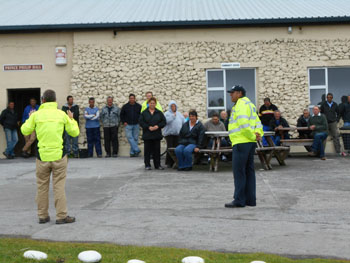 |
 |
| Heads of Households being briefed by Tristan da Cunha Administrator Alex Mitham outside the Prince Philip Hall with Inspector Conrad Glass alongside. Photos: Ovenstone Technicians Joseph Steyn and Craig Bergh | |
Report from Tristan Administrator Alex MithamOn Friday 5th December 2014 a disaster management exercise was arranged to coincide with Volcanologist Dr Anna Hicks and FCO Desk Officer Laura Benyohai’s visit on the Baltic Trader. The scenario involved a volcanic eruption behind the village which cut off access to the Patches and Pigbite, inevitably leading to the only evacuation point being the harbour. The Dong was rung at 12.00 and a briefing delivered by the Administrator Alex Mitham to all the heads of households at the Prince Philip Hall. It has been several years since the last exercise (again with Anna Hicks in attendance) and it was a good opportunity to see how our updated evacuation plans worked in practice. It should be noted that on 9th October 1961, when an eruption started behind the village, Administrator Peter Wheeler also gathered heads of households to order an evacuation along the road to the Potato Patches. Within 30 minutes of the briefing, everyone in the community had assembled at the harbour. The speed in response and organisation were excellent. The exercise not only ensured that everyone is aware of what needs to be done in the case of an evacuation, it also demonstrates that the island is more than capable of handling such an evacuation by itself. As everyone assembled at the harbour it once again highlighted the paucity in sea defences, as people had to take shelter from the waves crashing across the harbour wall (and this was on a relatively calm day). The pictures taken by Anna and Laura should send a clear message that the community take this issue seriously, and require a structure than can sustain their needs for generations to come. On this day MV Baltic Trader was available and Head of Communications Andy Repetto was monitoring nearby shipping and had identified several tankers who, in the event of an actual emergency may have been able to assist in evacuating the population, who numbered 285 on that day. I am immensely grateful for the whole community’s willingness and generosity in taking part in this exercise, especially on such a ‘blustery’ day. I would like this opportunity to also thank Conrad, Leon and Sharon Glass, Lorraine and Andy Repetto, Cynthia Green and Anna Hicks for running the exercise. |
|
 |
 |
| Scenes at Clashot Harbour where the 285 'evacuees' gathered | |
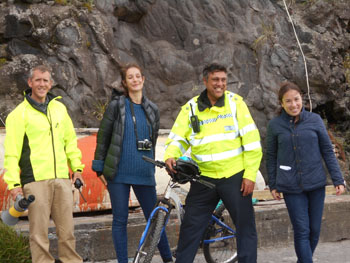 |
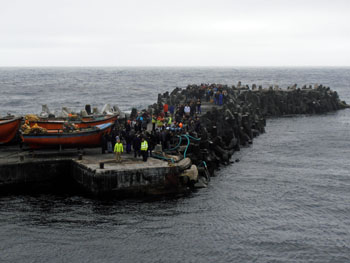 |
| Alex Mitham, FCO Desk Officer Laura Benyohai, Conrad Glass and Volcanologist Dr Anna Hicks. | Another scene of the crowded West Quay of Calshot Harbour during the exercise that reminded Islanders of their vulnerability living on act active volcanic island. |
 |
|
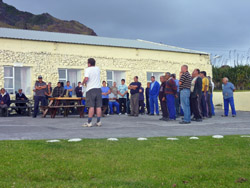 |
Evacuation Exercise on Monday 21st February 2011 |
||
| Administrator Sean Burns rings the gong to herald the Evacuation drill | The 1961 evacuation was heralded by Administrator Peter Wheeler who rang the gong on Monday 9th October. | Sean briefs Islanders outside the Prince Philip Hall - Peter Wheeler announced the initial phase of the 1961 evacuation inside the Prince Philip Hall. Photo: Anna Hicks |
 |
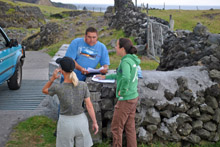 |
 |
| Traffic Jam as vehicles wait for checking at Hottentot Gulch Gate. Photo: Anna Hicks |
Marina Burns, Leon Glass and Anna Hicks check outgoing Islanders Photo: Sean Burns |
Anna Hicks and Leon Glass check names at Hottentot Gulch Gate Photo: Sean Burns |
 |
In 1961 the 264 Islanders and 31 expatriates walked to The Patches with hurriedly packed bags into a darkening dusk and accompanied by drizzle. |  |
| Everybody gathered on the Patches Plain Photo: Anna Hicks |
Like the October 1961 evacuation, the 2011 evacuation drill was on a wet day. Photo: Sean Burns |
|
 |
Surprise, Surprise! Many modern occurrences are unexpected, but, to many who visited Tristan da Cunha years ago, or have read about it in books, the site of a traffic jam on the Island's only road, is perhaps most unexpected! |
 |
| Traffic heading back to the village after a successful drill Photo: Sean Burns |
Bring up the rear in his police Land-Rover is Inspector Conrad Glass MBE Photo: Sean Burns |
